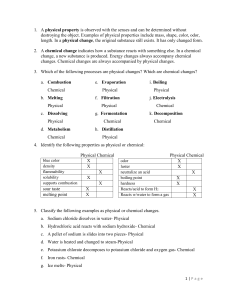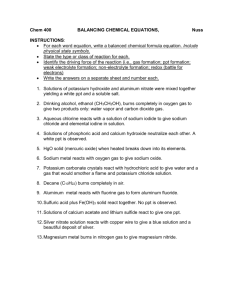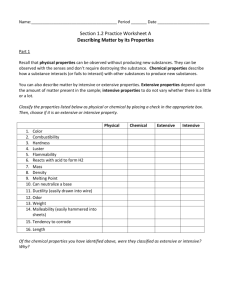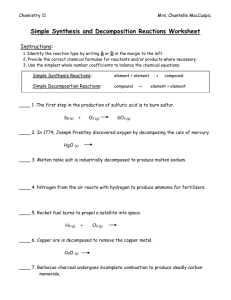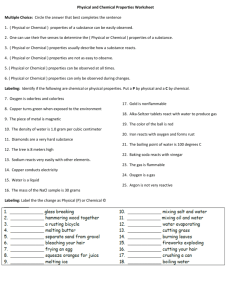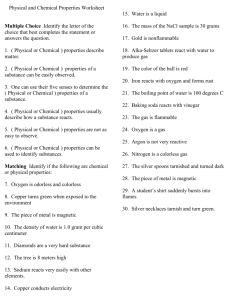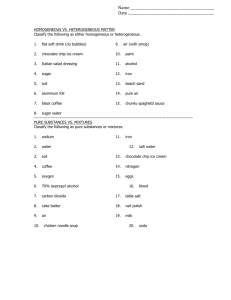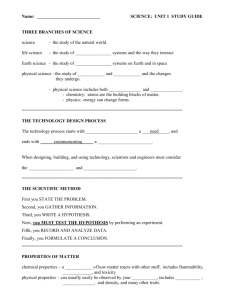2 Properties and Changes of Matter
advertisement
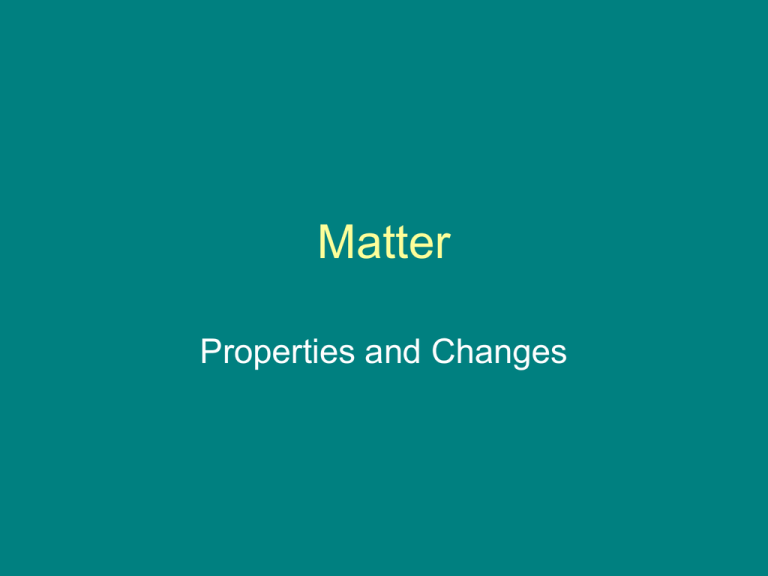
Matter Properties and Changes Properties of Matter • Physical properties: Any characteristic of a material you can observe without changing the identity of the substances in the material • Two separate categories of physical properties: • Behavior: what it can do –Examples: magnetism, ductility, malleability, thickness, density • Appearance: what you can see about it –Examples: color, size, shape, mass, temperature • Chemical property: a characteristic of a substance that indicates whether it can undergo a certain chemical change • Examples: flammability, reaction to light, how it bonds with other substances Topsail Science Physical and Chemical Properties Classify the following as either chemical property (cp) or a physical property (pp). 1. 2. 3. 4. 5. Red color Density Flammability Solubility Reacts with acid to form hydrogen 6. Supports combustion 7. Bitter taste 8. Melting point 9. Reacts with water to form a gas 10.Reacts with a base to form water 11.Hardness 12.Boiling point 13.Can neutralize a base 14.Luster 15.Odor Classify the following as either chemical property (cp) or a physical property (pp). 1. 2. 3. 4. 5. Red color PP Density PP Flammability CP Solubility PP Reacts with acid to form hydrogen CP 6. Supports combustion CP 7. Bitter taste PP 8. Melting point PP 9. Reacts with water to form a gas CP 10.Reacts with a base to form water CP 11.Hardness PP 12.Boiling point PP 13.Can neutralize a base CP 9. Luster PP 10.Odor PP Physical Change • ANY change that does NOT change the identity of the material –Examples: ripping in two, growing, freezing, melting, boiling, condensing, demagnetizing, temperature change, etc. • A special use of physical change: distillation –Used to separate a liquid from a mixture. –Boiling the liquid will cause it to evaporate –Evaporated liquid is made to condense elsewhere, leaving behind whatever was mixed in it • Some clues that a chemical change has occurred: –it produces: •Light and/or heat (energy) •Any physical change •Sound •A different smell •Bubbles (a gas) or precipitates (a solid) appear •the only sure way to test if a chemical change has occurred: •a new substance has been produced Mark and Molly Chemical and Physical Changes Classify the following as examples of a physical change (PC), chemical change (CC) , or both (B). 1. Sodium hydroxide dissolves water. 2. Hydrochloric acid reacts with sodium hydroxide to produce a salt, water and heat. 3. A pellet of sodium is sliced in two. 4. Water is heated and changed to steam. 5. Potassium chlorate decomposes to potassium chloride and oxygen gas. 6. Iron rusts. 7. Ice melts. 8. Acid on limestone produces carbon dioxide gas. 9. Milk sours. 10. Wood rots. Classify the following as examples of a physical change (PC), chemical change (CC) , or both (B). 1. Sodium hydroxide dissolves water. - PC 2. Hydrochloric acid reacts with sodium hydroxide to produce a salt, water and heat. - CC 3. A pellet of sodium is sliced in two. - PC 4. Water is heated and changed to steam. - PC 5. Potassium chlorate decomposes to potassium chloride and oxygen gas. - CC 6. Iron rusts. - CC 7. Ice melts. - PC 8. Acid on limestone produces carbon dioxide gas. CC 9. Milk sours. - CC 10. Wood rots. - CC • The Law of Conservation of Mass: during a chemical change, no matter is created or destroyed, it is only changed. • Therefore, the mass of all substances before a chemical change equals the mass of all substances after a chemical change
